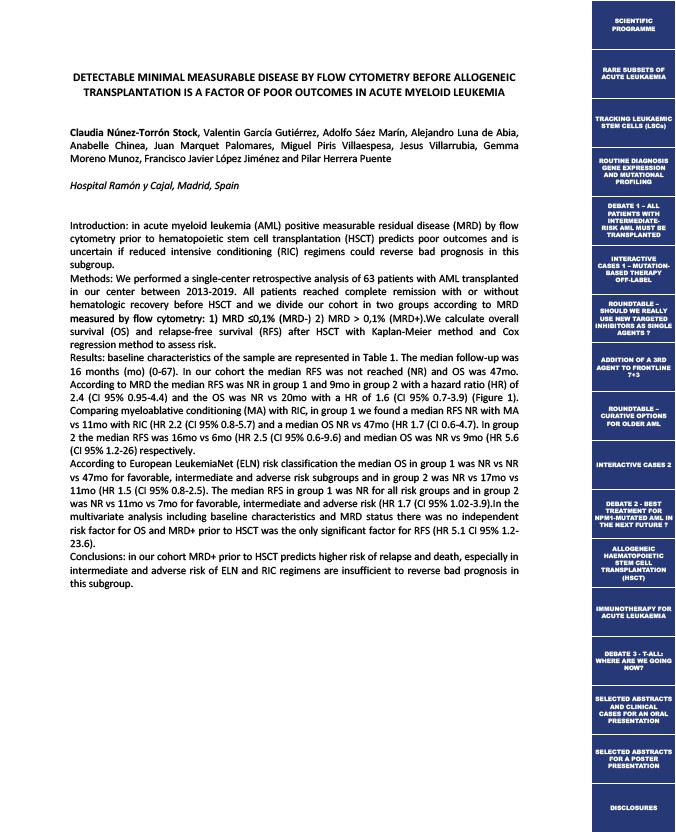
DETECTABLE MINIMAL MEASURABLE DISEASE BY FLOW CYTOMETRY BEFORE ALLOGENEIC
TRANSPLANTATION IS A FACTOR OF POOR OUTCOMES IN ACUTE MYELOID LEUKEMIA
Claudia Núnez-Torrón Stock, Valentin García Gutiérrez, Adolfo Sáez Marín, Alejandro Luna de Abia,
Anabelle Chinea, Juan Marquet Palomares, Miguel Piris Villaespesa, Jesus Villarrubia, Gemma
Moreno Munoz, Francisco Javier López Jiménez and Pilar Herrera Puente
Hospital Ramón y Cajal, Madrid, Spain
Introduction: in acute myeloid leukemia (AML) positive measurable residual disease (MRD) by flow
cytometry prior to hematopoietic stem cell transplantation (HSCT) predicts poor outcomes and is
uncertain if reduced intensive conditioning (RIC) regimens could reverse bad prognosis in this
subgroup.
Methods: We performed a single-center retrospective analysis of 63 patients with AML transplanted
in our center between 2013-2019. All patients reached complete remission with or without
hematologic recovery before HSCT and we divide our cohort in two groups according to MRD
measured by flow cytometry: 1) MRD ≤0,1% (MRD-) 2) MRD > 0,1% (MRD+).We calculate overall
survival (OS) and relapse-free survival (RFS) after HSCT with Kaplan-Meier method and Cox
regression method to assess risk.
Results: baseline characteristics of the sample are represented in Table 1. The median follow-up was
16 months (mo) (0-67). In our cohort the median RFS was not reached (NR) and OS was 47mo.
According to MRD the median RFS was NR in group 1 and 9mo in group 2 with a hazard ratio (HR) of
2.4 (CI 95% 0.95-4.4) and the OS was NR vs 20mo with a HR of 1.6 (CI 95% 0.7-3.9) (Figure 1).
Comparing myeloablative conditioning (MA) with RIC, in group 1 we found a median RFS NR with MA
vs 11mo with RIC (HR 2.2 (CI 95% 0.8-5.7) and a median OS NR vs 47mo (HR 1.7 (CI 0.6-4.7). In group
2 the median RFS was 16mo vs 6mo (HR 2.5 (CI 95% 0.6-9.6) and median OS was NR vs 9mo (HR 5.6
(CI 95% 1.2-26) respectively.
According to European LeukemiaNet (ELN) risk classification the median OS in group 1 was NR vs NR
vs 47mo for favorable, intermediate and adverse risk subgroups and in group 2 was NR vs 17mo vs
11mo (HR 1.5 (CI 95% 0.8-2.5). The median RFS in group 1 was NR for all risk groups and in group 2
was NR vs 11mo vs 7mo for favorable, intermediate and adverse risk (HR 1.7 (CI 95% 1.02-3.9).In the
multivariate analysis including baseline characteristics and MRD status there was no independent
risk factor for OS and MRD+ prior to HSCT was the only significant factor for RFS (HR 5.1 CI 95% 1.2-
23.6).
Conclusions: in our cohort MRD+ prior to HSCT predicts higher risk of relapse and death, especially in
intermediate and adverse risk of ELN and RIC regimens are insufficient to reverse bad prognosis in
this subgroup.
SCIENTIFIC
PROGRAMME
RARE SUBSETS OF
ACUTE LEUKAEMIA
TRACKING LEUKAEMIC
STEM CELLS (LSCs)
ROUTINE DIAGNOSIS
GENE EXPRESSION
AND MUTATIONAL
PROFILING
DEBATE 1 – ALL
PATIENTS WITH
INTERMEDIATE-RISK
AML MUST BE
TRANSPLANTED
INTERACTIVE
CASES 1 – MUTATION-BASED
THERAPY
OFF-LABEL
ROUNDTABLE –
SHOULD WE REALLY
USE NEW TARGETED
INHIBITORS AS SINGLE
AGENTS ?
ADDITION OF A 3RD
AGENT TO FRONTLINE
7+3
ROUNDTABLE –
CURATIVE OPTIONS
FOR OLDER AML
INTERACTIVE CASES 2
DEBATE 2 - BEST
TREATMENT FOR
NPM1-MUTATED AML IN
THE NEXT FUTURE ?
ALLOGENEIC
HAEMATOPOIETIC
STEM CELL
TRANSPLANTATION
(HSCT)
IMMUNOTHERAPY FOR
ACUTE LEUKAEMIA
DEBATE 3 - T-ALL:
WHERE ARE WE GOING
NOW?
SELECTED ABSTRACTS
AND CLINICAL
CASES FOR AN ORAL
PRESENTATION
SELECTED ABSTRACTS
FOR A POSTER
PRESENTATION
DISCLOSURES